If you want to learn how to draw comics you can go to the art section of any bookstore and pick up books that will tell you how to draw the marvel way, how to draw manga, how to draw cutting edge comics, how to draw villains, women, horror, military, etc. But drawing characters is different than making comics. Will Eisner was the generator of the term ‘sequential art’ and the first popular theory of comics. Scott McCloud is his recent successor. Eisner created the vocabulary of sequential art in his long-running course at the School of Visual Arts in NYC. McCloud helped a generation of comic book readers grasp that vocabulary in Understanding Comics, by creating a graphic novel that employed comic art to explain comic theory. But both Eisner and McCloud wrote about a time when comic delivery was bound to newspapers and twenty-two page glossy, stapled pages.
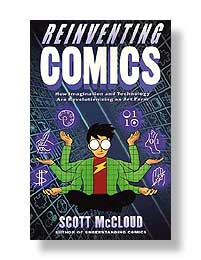
Whither the network? McCloud treats the possibilities of the Internet in his second book, Reinventing Comics, but mostly as a distribution mechanism. We shouldn’t overlook the powerful affect the ‘net has had on individual producers who, in the past, would have created small runs of photocopied books to distribute locally. Now, of course, they can put their panels on the web and have a potential audience of millions. Some even make a jump from the web into print. Most web comics are sufficiently happy to ride the network to a wider audience without exploring the ‘net as vehicle to transform comics into uniquely non-print artifacts with motion, interactivity, sound.
But how might comics mutate on the web? At the recent ITP Spring show I saw a digital comics project from Tracy Ann White’s class. The class asks the question: “What happens when comics evolve from print to screen? How does presentation change to suit this shift?” Sounds like familiar territory. White, a teacher at ITP, has been a long time web comic artist (one of the first on the web, and certainly one of the first to incorporate comments and forums as part of the product.
When I did a little research on her, I found an amazing article on Webcomics Review discussing the history of web comics. (There’s also more from White there.) There has been some brilliant work done, making use of scrolling as part of the “infinite canvas,” but more importantly, work that could have no print analog due the incorporation of sound and motion. The discussion in Webcomics Review covers all of the transformative effects of online publishing that we talk about here at the Institute: interlinking, motion, sound, and more profoundly, the immediacy and participative aspects of the network. As an example, James Kochalka, well known for his Monkey vs. Robot comics and a simplistic cartoon style, publishes An American Elf. The four panel personal vignette is published daily-blogging with comics.
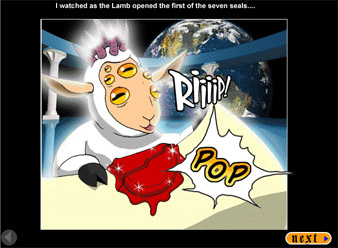
Other ground breaking work: Nowhere Girl by Justine Shaw, a long form graphic novel that proved that people will read lengthy comics online. Apocamon by Patrick Farley, is a mash up of Pokemon and The Book of Revelations. There is a well known series of bible stories in comic strip format – this raises that tradition to the level of heavenly farce (with anime). Apocamon judiciously uses sound and minor animation effects to create a rich reading experience, but relies on pages—a mode immediately familiar to comic book readers. The comics on Magic Inkwell (Cayetano Garza) use music and motion graphics in a more experimental way. And in Broken Saints we find an example where comic conventions (words in a comic style font, speech bubbles, and sequential images) fade into cinema.
As new technology enables stylistic enhancements to web comics, the boundaries between comics and other media will become more blurred. White says, “In terms of pushing interactive storytelling online games are at the forefront.” This is true, but online games dispense with important conventions that make comics comics. The next step for online comics is to enhance their networked and collaborative aspect while preserving the essential nature of comics as sequential art.
Category Archives: digital_literature
subtitles and the future of reading
After enduring a weeks-long PR pummeling for its dealings in China, Google is hard at work to improve its image in the world, racking up some points for good after slipping briefly into evil. Recently they launched Google.org: a website for the Google Foundation, the corporation’s philanthropic arm and central office of evil mitigation. Paying a visit to the site, the disillusioned among us will be pleased to find that the foundation is already sponsoring a handful of worthy initiatives, along with a grants program that donates free web advertising to nonprofit organizations. And just in case we were concerned that Google might not apply its techno-capitalist wizardry to altruism as zealously as to making profit, they just announced today they’ve named a new director for the foundation by the name of — no joke — Dr. Brilliant. So it seems the world is in capable hands.
One project in particular caught my eye in light of recent discussions about screen-based reading and genre-blending visions of the book. Planet Read is an organization that promotes literacy in India through Same Language Subtitling — a simple but apparently effective technique for building basic reading skills, taking popular visual entertainment like Bollywood movies and adding subtitles in English and Hindi along the bottom of the screen. A number of samples (sadly no Bollywood, just videos or photo montages set to Indian folk songs) can be found on Google Video. Here’s one that I particularly liked:
Watching the video — managing the interplay between moving text and moving pictures — I began to wonder whether there are possibly some clues to be mined here about the future of reading. Yes, Planet Read is designed first and foremost to train basic alphabetic literacy, turning a captive audience into a captive classroom. But in doing so, might it not also be nurturing another kind of literacy?
The problem with contemporary discussions about the future of the book is that they are mired — for cultural and economic reasons — in a highly inflexible conception of what a book can be. People who grew up with print tend to assume that going digital is simply a matter of switching containers (with a few enhancements thrown in the mix), failing to consider how the actual content of books might change, or how the act of reading — which increasingly takes place in a dyanamic visual context — may eventually demand a more dynamic kind of text.
Blurring the lines between text and visual media naturally makes us uneasy because it points to a future that quite literally (for us dinosaurs at least) could be unreadable. But kids growing up today, in India or here in the States, are already highly accustomed to reading in screen-based environments, and so they probably have a somewhat different idea of what reading is. For them, text is likely just one ingredient in a complex combinatory medium.
Another example: Nochnoi Dozor (translated “Night Watch”) is a film that has widely been credited as the first Russian blockbuster of the post-Soviet era — an adrenaline-pumping, special effects-infused, sci-fi vampire epic made entirely by Russians, on Russian soil and on Russian themes (it’s based on a popular trilogy of novels). When it was released about a year and a half ago it shattered domestic box office records previously held by Western hits like Titanic and Lord of the Rings. Just about a month ago, the sequel “Day Watch” shattered the records set by “Night Watch.”

While highly derivative of western action movies, Nochnoi Dozor is moody, raucous and darkly gorgeous, giving a good, gritty feel of contemporary Moscow. Its plot grows rickety in places, and sometimes things are downright incomprehensible (even, I’m told, with fluent Russian), so I’m skeptical about its prospects on this side of the globe. But goshdarnit, Russians can’t seem to get enough of it — so in an effort to lure American audiences over to this uniquely Russian gothic thriller, start building a brand out of the projected trilogy (and presumably pave the way for the eventual crossover to Hollywood of director Timur Bekmambetov), Fox Searchlight just last week rolled the film out in the U.S. on a very limited release.
What could this possibly have to do with the future of reading? Well, naturally the film is subtitled, and we all know how subtitles are the kiss of death for a film in the U.S. market (Passion of the Christ notwithstanding). But the marketers at Fox are trying something new with Nochnoi Dozor. No, they weren’t foolish enough to dub it, which would have robbed the film of the scratchy, smoke-scarred Moscow voices that give it so much of its texture. What they’ve done is played with the subtitles themselves, making them more active and responsive to the action in the film (sounds like some Flash programmer had a field day…). Here’s a description from an article in the NY Times (unfortunately now behind pay wall):
…[the words] change color and position on the screen, simulate dripping blood, stutter in emulation of a fearful query, or dissolve into red vapor to emulate a character’s gasping breaths.
And this from Anthony Lane’s review in the latest New Yorker:
…the subtitles, for instance, are the best I have encountered. Far from palely loitering at the foot of the screen, they lurk in odd corners of the frame and, at one point, glow scarlet and then spool away, like blood in water. I trust that this will start a technical trend and that, from here on, no respectable French actress will dream of removing her clothes unless at least three lines of dialogue can be made to unwind across her midriff.
It might seem strange to think of subtitling of foreign films as a harbinger of future reading practices. But then, with the increasing popularity of Asian cinema, and continued cross-pollination between comics and film, it’s not crazy to suspect that we’ll be seeing more of this kind of textual-visual fusion in the future.
Most significant is the idea that the text can itself be an actor in a perfomance: a frontier that has only barely been explored — though typography enthusiasts will likely pillory me for saying so.
quoting a quote
Bud Parr, author of the blog Chekhov’s Mistress and commenter on if:book, recently posted on a speech given by Susan Sontag, entitled “Literature is Freedom.”
Quoting, his favorite quote:
A writer, I think, is someone who pays attention to the world. That means trying to understand, take in, connect with, what wickedness human beings are capable of; and not be corrupted – made cynical, superficial – by this understanding.
Literature can tell us what the world is like.
Literature can give us standards and pass on deep knowledge, incarnated in language, in narrative.
Literature can train, and exercise, our ability to weep for those who are not us or ours.
At the institute, we often describe the “book” as both a vessel (technology) and text (information) especially as we work on revising our mission statement. Even so, and only speaking for myself, it is still very easy to get caught up in things like networks, copyright policy, and Web 2.0, which are, of course, all important topics. Sontag’s quote is a good reminder of not just what resides in the vessel of the book, but why its contents are valuable.
LONGPLAYER
when i was growing up they started issuing LP albums which played at 33 1/3 rpm, vastly increasing the amount of playing time on one side of a record. before the LP, audio was recorded and distributed on brittle discs made of shellac, running at 78rpm. 78s had a capacity of about 12 minutes; LPs upped that to about 30 minutes which made it possible for classical music fans to listen to an entire movement without changing discs and enabled  the development of the rock and roll album.
the development of the rock and roll album.
in 2,000 Jem Finer, a UK-based artist released Longplayer, a 1000-year musical composition that runs continuously and without repetition from its start on January 1, 2000 until its completion on December 31, 2999. Related conceptually to the Long Now project which seeks to build a ten-thousand year clock, Longplayer uses generative forms of music to make a piece that plays for ten to twelve human lifetimes. Longplayer challenges us to take a longer view which takes account of the generations that will come after us.
the longplayer also reminds me of an idea i’ve been intrigued by — the possiblity of (networked) books that never end because authors keep adding layers, tangents and new chapters.
Finer published a book about Longplayer which includes a vinyl disc (LP actually) with samples.
electronic literature collection – call for works
The Electronic Literature Organization seeks submissions for the first Electronic Literature Collection. We invite the submission of literary works that take advantage of the capabilities and contexts provided by the computer. Works will be accepted until January 31, 2006. Up to three works per author will be considered.
The Electronic Literature Collection will be an annual publication of current and older electronic literature in a form suitable for individual, public library, and classroom use. The publication will be made available both online, where it will be available for download for free, and as a packaged, cross-platform CD-ROM, in a case appropriate for library processing, marking, and distribution. The contents of the Collection will be offered under a Creative Commons license so that libraries and educational institutions will be allowed to duplicate and install works and individuals will be free to share the disc with others.
The editorial collective for the first volume of the Electronic Literature Collection, to be published in 2006, is:
N. Katherine Hayles
Nick Montfort
Scott Rettberg
Stephanie Strickland
Go here for full submission guidelines.
creative versioning project
“I don’t have a single early draft of any novel or story. I just ‘saved’ over the originals until I reached the final version. All there is is the books themselves.” – Zadie Smith
This is a call (re-published from the Electronic Literature Organization) for writers to participate in a creative versioning project, hopefully to begin this winter:
Matthew Kirschenbaum is looking for poets and fiction writers willing to participate in a project to archive versions of texts in progress. An electronic document repository (known as a Concurrent Versions System, or CVS) will be used to track revisions and changes to original fiction and poetry contributed by participating writers who will work by checking their drafts in and out of the repository system. The goal is to provide access to a work at each and every state of its composition and conceptual evolution — thereby capturing the text as a living, dynamic object-in-the-making rather than a finished end-product. A reader will be able to watch the composition process unfold as though s/he were looking over the writer’s shoulder.
For guidelines and contact info, visit ELO.
nyc2123: a graphic novel for psp

NYC2123 is a graphic novel conceived for the 480 by 272-pixel screen of the Play Station Portable video game device. It’s a post-apocalyptic tale set in a future, tsunami-ravaged New York in which the city’s wealthy have walled off the island of Manhattan against a violent river society of junkies, thieves and outlaw barges.
There are several sequences that read like a flip book, taking advantage of the single-frame interface and the fact that the reader has literally got his finger on the button. Quickly flipping through the panels creates a filmic effect, as here:
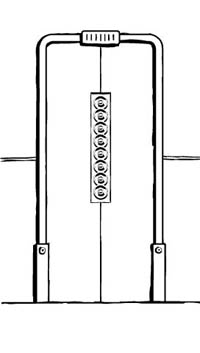
![]()
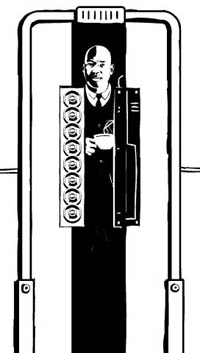
![]()
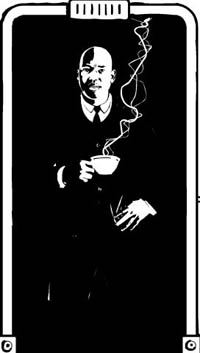
(Once again via Infocult – thanks Bryan)
Update: Someone has just developed a .pdf reader for the PSP.
a book is not a text: the noise made by people

Momus – a.k.a. Nick Currie, electronic folk musician, Wired columnist, and inveterate blogger – has posted an interesting short video on his blog, Click Opera. He’s teaching a class on electronic music composition & narrative for Benneton’s Fabrica in Venice. His video encourages students to listen for the environmental sounds that they can make with electronic instruments: not the sounds that they’re designed to make, but the incidental noises that they make – the clicking of keys on a Powerbook, for example – that we usually ignore as being just that, incidental. We ignore the fact that these noises are made directly by people, without the machine’s intercession.
Momus’s remarks put me in mind of something said by Jerome McGann at the Transliteracies conference in Santa Barbara last June – maybe the most important thing that was said at the conference, even if it didn’t warrant much attention at the time. What we tend to forget when talking about reading, he said, was that books – even regular old print books – are full of metadata. (Everybody was talking about metadata in June, like they were talking about XML a couple of years ago – it was the buzzword that everyone knew they needed to have an opinion about. If not, they swung the word about feverishly in the hopes of hitting something.) McGann qualified his remarks by referring to Ezra Pound’s idea of melopoeia, phanopoeia, and logopoeia – specific qualities in language that make it evocative:
. . . you can still charge words with meaning mainly in three ways, called phanopoeia, melopoeia, logopoeia. You can use a word to throw a visual image on to the reader’s imagination, or you charge it by sound, or you use groups of words to do this.
(The ABC of Reading, p.37) In other words, words aren’t always just words: when used well, they refer beyond themselves. This process of referring, McGann was claiming, is a sort of metadata, even if technologists don’t think about it this way: the way in which words are used provides the attuned reader with information about their composition beyond the meaning of the words themselves.
But thinking about McGann’s comments in terms of book design might suggest wider implications for the future of the book. Let’s take a quick excursion to the past of the book. Once it was true that you couldn’t judge a book by its cover. Fifty years ago, master book designer Jan Tschichold opined about book jackets:
A jacket is not an actual part of the book. The essential portion is the inner book, the block of pages . . . [U]nless he is a collector of book jackets as samples of graphic art, the genuine reader discards it before he begins.
(“Jacket and Wrapper,” in The Form of the Book: Essays on the Morality of Good Design) Tschichold’s statement seems bizarre today: nobody throws away book jackets, especially not collectors. Why? Because today we take it for granted that we judge books by their covers. The cover has been subsumed into our idea of the book: it’s a signifying part of the book. By looking at a cover, you, the prospective book-buyer, can immediately tell if a recently-published piece of fiction is meant to be capital-L Literature, Nora Roberts-style fluff, or somewhere in between. Contextual details like the cover are increasingly important.
Where does the electronic book fit into this, if at all? Apologists for the electronic book are constantly about the need for an ideal device as the be-all and end-all: when we have e-Ink or e-Paper and a well-designed device which can be unrolled like a scroll, electronic books will suddenly take off. This isn’t true, and I think it has something to do with the way people read books, something that hasn’t been taken into account by soi-disant futurists, and something like what Jerome McGann was gesturing at. A book is not a text. It’s more than a text. It’s a text and a collection of information around that text, some of which we consciously recognize and some of which we don’t.
A few days ago, I excoriated Project Gutenberg’s version of Tristram Shandy. This is why: a library of texts is not the same thing as a library of books. A quick example: download, if you wish, the plain text or HTML version of Tristram Shandy, which you can get here. Look at the opening pages of the HTML version. Recognizing that this particular book needs to be more than plain old seven-bit ASCII, they’ve included scans of the engravings that appear in the book (some by William Hogarth, like this; a nice explication of this quality of the book can be found here). What’s interesting to me about these illustrations that Project Gutenberg is how poorly done these are. These are – let’s not beat around the bush – bad scans. The contrast is off; things that should be square look rectangular. The Greek on the title page is illegible.
Let’s go back to Momus listening to the unintentional noises made by humans using machines: what we have here is the debris of another noisy computer, the noise of a key that we weren’t supposed to notice. Something about the way these scans is dated in a very particular way – half of the internet looked like this in 1997, before everyone learned to use Photoshop properly. Which is when, in fact, this particular document was constructed. In this ugliness we have, unintentionally, humanity. John Ruskin (not a name often conjured with when talking about the future) declared that one of the hallmarks of the Gothic as an architectural style was a perceived “savageness”: it was not smoothed off like his Victorian contemporaries would have liked. But “savageness”, for him, was no reproach: instead, it was a trace of the labor that went into it, a trace of the work’s humanity. Perfection, for him, was inhumane: humanity
. . . was not intended to work with the accuracy of tools, to be precise and perfect in all their actions. If you will have that precision out of them, and make their fingers measure degrees like cog-wheels, and their arms strike curves like compasses, you must unhumanize them . .
(The Stones of Venice) What we have here is, I think, something similar. While Project Gutenberg is probably ashamed of the quality of these graphics, there’s something to be appreciated here. This is a text on its way to becoming a book; it unintentionally reveals its human origins, the labor of the anonymous worker who scanned in the illustrations. It’s a step in the right direction, but there’s a great distance still to go.
“the minotaur project” featured at ELO
Kim’s hypermedia poem cluster, “The Minotaur Project,” is currently featured at the Electronic Literature Organization. Highly recommended.
ron silliman: “the chinese notebook”
5. Language is, first of all, a political question.
 Like the problem of hunger in the world, the problem with publishing in the United States isn’t one of supply but one of distribution.
Like the problem of hunger in the world, the problem with publishing in the United States isn’t one of supply but one of distribution.
What’s worried me lately: that I go to airport bookshops and always see the same books. Because I live in New York, I can go to any number of specialized bookshops & find just about anything I want. The same is not true in many other parts of the country; the same is certainly not true in many other parts of the world. What worries me about airport bookshops is how few books they carry: how narrow a range of ideas is presented. May God help you if you’d like to buy anything other than Dan Brown in the Minneapolis/St. Paul airport. This is an exaggeration, but not by much. James Patterson is also available, as are the collected works of J. K. Rowling, and, for a limited time, those of J. R. R. Tolkien.
Into this emptiness is paraded the miracle of electronic publishing. As pushed by Jason Epstein, amongst others, the idea of print-on-demand will solve the question of supply forever more – you could go to a bookstore, request a book, and Barnes & Noble would print it out for you. (Let’s not think about copyright for the moment.) Jason Epstein believes these machines will be small enough to fit into an airport bookstore. This hasn’t happened yet, and I’m doubtful that it will any time soon, if at all. Booksellers have the supply & distribution issue down cold for Brown & Patterson & J. K. Rowling – they have no incentive to invest in these machines. When was the last time you, member of the reading public, went to complain to Barnes & Noble about their selection?
Until this marvelous future creates itself out of publishers’ good will towards humanity, people are presenting texts online, with varying degrees of success. If you have a laptop in the MSP airport (& a credit card to pay for wireless internet there), or, for that matter, any computer connected to the internet, you can go to ubu.com and browse their archive of documents of the avant-garde. Among the treasures are /ubu editions, an imprint that electronically reprints various texts as PDFs. They’re free. I have a copy of Ron Silliman’s The Chinese Notebook, a reprint of a 26-page poem which originally appeared in The Age of Huts. Ubu reprinted it (and the other two parts of The Age of Huts) with Silliman’s permission.
6. I wrote this sentence with a ballpoint pen. If I had used another, would it be a different sentence?
/Ubu editions (edited by Brian Kim Stefans) aren’t really electronic books, and don’t conceive of themselves as such. Rather, they are a way of electronically distributing a book. This PDF is 8.5” x 11”. While you can read it from a screen – I did – it’s meant to be printed out at home & read on paper. That said, this isn’t a quick and dirty presentation. Somebody (a mysterious “Goldsmith”) has gone to the trouble of making it an attractive object. It has a title page with attractive, interesting, and appropriate art (an interactive study by Mel Bochner from Aspen issue 5–6; ubu.com graciously hosts this online as well). There’s a copyright page that explains the previous. There’s even a half title page – somebody clearly knows something about book design. (How useful a half title page is in a book that’s meant to be printed out I’m not sure. It’s a pretty half title page, but it’s using another piece of your paper to print itself.) There’s also a final page, rounding off the total to 30 pages; if you print this off double-sided, you’ll have your very own beautiful stack of paper.
(Which is better than nothing.)
8. This is not speech. I wrote it.
Silliman’s text is (as these quotes might suggest) a list of 223 numbered thoughts about poetry and writing that forms a (self-contained) poem in prose. It is explicitly concerned with the form of language.
Karl Marx anticipating Walter J. Ong: “Is the Iliad possible when the printing press, and even printing machines, exist? Is it not inevitable that with the emergence of the press, the singing and the telling and the muse cease; that is, that the conditions necessary for epic poetry disappear?” (The German Ideology, p. 150; quoted in Neil Postman’s A Bridge to the 18th Century: How the Past Can Improve Our Future).
17. Everything here tends away from an aesthetic decision, which, in itself, is one.
Silliman’s text is nicely set – not beautifully, but well enough, using Baskerville. Baskerville is a neoclassical typeface, cool and rational, a product of the 18th century. Did Silliman think about this? Was the designer thinking about this? Is this how his book looked in print? in the eponymous Chinese notebook in which he wrote it? I don’t know, although my recognition of the connotations of the type inflects itself on my reading of Silliman’s poem.
21. Poem in a notebook, manuscript, magazine, book, reprinted in an anthology. Scripts and contexts differ. How could it be the same poem?
Would Silliman’s poem be the same poem if it were presented as, say, HTML? Could it be presented as HTML? This section of The Age of Huts is prose and could be without too many changes; other sections are more dependent on lines and spacing. Once a poem is in a PDF (or on a printed page), it is frozen, like a bug in amber; in HTML, type wiggles around at the viewer’s convenience. (I speak of the horrors HTML can wreak on poetry from some experience: in the evenings, I set non-English poems (in print, for the most part) for Circumference.)
47. Have we come so very far since Sterne or Pope?
Neil Postman, in his book, wonders about the same thing, answers “no”, and explains that in fact we’ve gone backwards. Disappointingly, there’s little reference to Sterne in Postman’s book, although he does point out that Oliver Goldsmith’s The Vicar of Wakefield was more widely read in the eighteenth century: possibly the literary public has never cared for the challenging.
Project Gutenberg happily presents their version of Tristram Shandy online in a plain text version: at certain points, the reader sees “(two marble plates)” or “(two lines of Greek)” and is left to wonder how much the text has changed between the page and the screen. Sterne’s novel, like Pope’s poetry, is agreeably self-aware: how Sterne would have laughed at “(page numbering skips ten pages)” in an edition without page numbers. There are a few lapses in ubu.com’s presentation of Silliman, but they’re comparably minor: some of the entries in Silliman’s list aren’t separated by a blank space, leading one to suspect the pagination was thrown out of whack in Quark. When something’s free . . .
53. Is the possibility of publishing this work automatically a part of the writing? Does it alter decisions in the work? Could I have written that if it did not?
A writer writes to communicate with a reader unknown. Publishers publish to make money. These statements are not always true – there’s no shortage of craven writers if there’s a sad dearth of virtuous publishers – but they can be taken as general rules of thumb. Where does electronic publishing fit into this set of equations? Certainly when Silliman was writing this twenty years ago he wasn’t thinking seriously about distributing his work over the Internet.
(Silliman has, for what it’s worth, an excellent blog, suggesting that had the possiblity been around twenty years ago, he would have been thinking about it.)
56. As economic conditions worsen, printing becomes prohibitive. Writers posit less emphasis on the page or book.
Why does ubu.com’s reprinting of Ron Silliman’s poetry seem more interesting to me than what Project Gutenberg is doing? Even the cheapest edition of Tristram Shandy that I can buy looks better than what they put out. (Ashamed of their text edition, one supposes, they’ve put out an HTML version of the book, which is an improvement, but not enough of one that I’d consider reading it for six hundred pages.) More to the point: it’s not that hard to find a copy of Tristram Shandy. You can even find one in one of the better airport bookstores. It’s out of copyright and any would-be publisher who wants to can print their own version of it without bothering with paying for rights.
I could not, alas, go to a bookstore and buy myself a copy of The Age of Huts because it’s been out of print for years. Thanks a lot, publishing. Good work. I could go to Amazon.com and buy a “used/collectible” copy for $113.20 – but precisely none of that money would go to Ron Silliman. But I don’t want a collectible copy: I’m interested in reading Silliman, not hoarding him. (Perhaps I start to contradict myself here.)
223. This is it.
But there are still questions. How do we ascribe value to a piece of art in a market economy? Are Plato’s ideas less valuable than those of Malcolm Gladwell because you can easily pick up the collected works of the first for less than 10% of what the two books of the second would cost you? when you can download old English translations for free on the Internet?
How valuable is a free poem on the Internet? How much more valuable is an attractive edition of a free poem on the Internet? even if you have to print it out to read it?
Why aren’t more people doing this?
